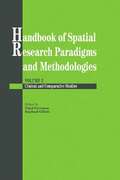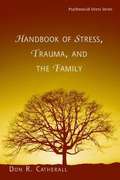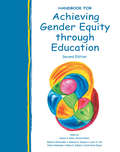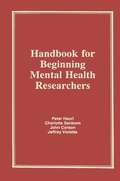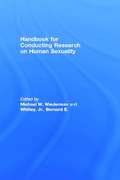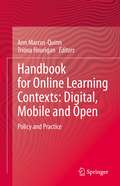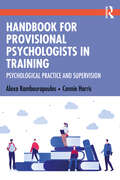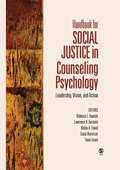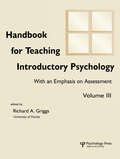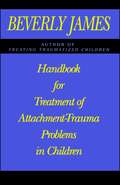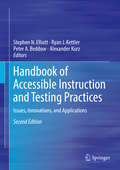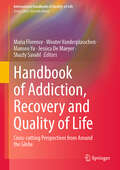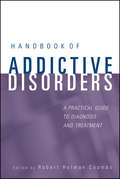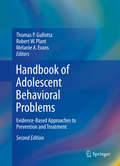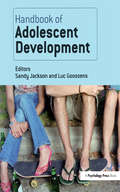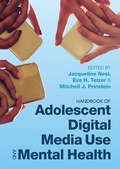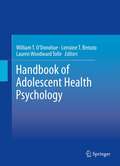- Table View
- List View
Handbook Of Spatial Research Paradigms And Methodologies
by Nigel Foreman Raphael GillettSpatial cognition is a broad field of enquiry, emerging from a wide range of disciplines and incorporating a wide variety of paradigms that have been employed with human and animal subjects. This volume is part of a two- volume handbook reviewing the major paradigms used in each of the contributors' research areas.; This volume considers the issues of neurophysiological aspects of spatial cognition, the assessment of cognitive spatial deficits arising from neural damage in humans and animals, and the observation of spatial behaviours in animals in their natural habitats.; This handbook should be of interest to new and old students alike. The student new to spatial research can be brought up-to- speed with a particular range of techniques, made aware of the background and pitfalls of particular approaches, and directed toward useful sources. For seasoned researchers, the handbook provides a rapid scan of the available tools that they might wish to consider as alternatives when wishing to answer a particular "spatial" research problem.
Handbook Of Spatial Research Paradigms And Methodologies
by Nigel Foreman Raphael GillettSpatial cognition is a broad field of enquiry, emerging from a wide range of disciplines and incorporating a wide variety of paradigms that have been employed with human and animal subjects. This volume is part of a two- volume handbook reviewing the major paradigms used in each of the contributors' research areas.; This volume considers the issues of neurophysiological aspects of spatial cognition, the assessment of cognitive spatial deficits arising from neural damage in humans and animals, and the observation of spatial behaviours in animals in their natural habitats.; This handbook should be of interest to new and old students alike. The student new to spatial research can be brought up-to- speed with a particular range of techniques, made aware of the background and pitfalls of particular approaches, and directed toward useful sources. For seasoned researchers, the handbook provides a rapid scan of the available tools that they might wish to consider as alternatives when wishing to answer a particular "spatial" research problem.
Handbook Of Stress, Trauma, And The Family (Routledge Psychosocial Stress)
by Don R. CatherallThe Handbook of Stress, Trauma, and the Family is broken down into three sections, compiling research, theory and practice. The first section focuses on how traumatic stress affects intimate others, what familial characteristics affect individual susceptibility to trauma, as well as evaluation of the effectiveness of various interventions. The section on theory explores concepts of stress and intrapsychic processes underlying the intergenerational transmission of trauma, addressesing how families can buffer or enhance anxiety. The final section, entitled practice, covers assessment (presenting both the Circumplex Model and Bowenian family theory models), treatment models and treatment formats for specific populations. The major family treatment models applicable to stress and trauma are discussed, including contextual, object relations, emotionally focused and critical interaction therapy.
Handbook Of Structured Techniques In Marriage And Family Therapy
by Robert Sherman Norman FredmanPublished in the year 1986, Handbook of Structured Techniques in Marriage and Family Therapy is a valuable contribution to the field of Family Therapy.
Handbook for Achieving Gender Equity Through Education
by Susan S. KleinFirst published in 1985, the Handbook for Achieving Gender Equity Through Education quickly established itself as the essential reference work concerning gender equity in education. This new, expanded edition provides a 20-year retrospective of the field, one that has the great advantage of documenting U.S. national data on the gains and losses in the efforts to advance gender equality through policies such as Title IX, the landmark federal law prohibiting sex discrimination in education, equity programs and research. Key features include: Expertise – Like its predecessor, over 200 expert authors and reviewers provide accurate, consensus, research-based information on the nature of gender equity challenges and what is needed to meet them at all levels of education. Content Area Focus – The analysis of gender equity within specific curriculum areas has been expanded from 6 to 10 chapters including mathematics, science, and engineering. Global/Diversity Focus – Global gender equity is addressed in a separate chapter as well as in numerous other chapters. The expanded section on gender equity strategies for diverse populations contains seven chapters on African Americans, Latina/os, Asian and Pacific Island Americans, American Indians, gifted students, students with disabilities, and lesbian, gay, bisexual, and transgender students. Action Oriented – All chapters contain practical recommendations for making education activities and outcomes more gender equitable. A final chapter consolidates individual chapter recommendations for educators, policymakers, and researchers to achieve gender equity in and through education. New Material – Expanded from 25 to 31 chapters, this new edition includes: *more emphasis on male gender equity and on sexuality issues;*special within population gender equity challenges (race, ability and disability, etc);*coeducation and single sex education;*increased use of rigorous research strategies such as meta-analysis showing more sex similarities and fewer sex differences and of evaluations of implementation programs;*technology and gender equity is now treated in three chapters;*women’s and gender studies;*communication skills relating to English, bilingual, and foreign language learning; and*history and implementation of Title IX and other federal and state policies. Since there is so much misleading information about gender equity and education, this Handbook will be essential for anyone who wants accurate, research-based information on controversial gender equity issues—journalists, policy makers, teachers, Title IX coordinators, equity trainers, women’s and gender study faculty, students, and parents.
Handbook for Beginning Mental Health Researchers
by Charlotte SanbornIn fulfilling the need for a beginner's manual in mental health research, the authors have written an insightful exposition of the fundamental factors essential to good research. This articulately written manual teaches how to formulate a clear hypothesis, select a representative population, conduct a valid study, and describe results in an intelligible manner. The experienced authors thoroughly explain the need for acquiring a research attitude--an inquiring and critical mind--and then discuss how mental health research is done, using anecdotal case reports, studies with only a few variables, and complex investigations of multiple variables as examples. A wide range of research possiblilities is explored, including those that require little or no financial support.
Handbook for Conducting Research on Human Sexuality
by Michael W. Wiederman Bernard E. WhitleyHuman sexuality researchers often find themselves faced with questions that entail conceptual, methodological, or ethical issues for which their professional training or prior experience may not have prepared them. The goal of this handbook is to provide that guidance to students and professionals interested in the empirical study of human sexuality from behavioral and social scientific perspectives. It provides practical and concrete advice about conducting human sexuality research and addresses issues inherent to both general social scientific and specific human sexuality research. This comprehensive resource offers a unique multidisciplinary examination of the specific methodological issues inherent in conducting human sexuality research. The methodological techniques and advances that are familiar to researchers trained in one discipline are often unfamiliar to researchers from other disciplines. This book is intended to help enrich the communication between the various disciplines involved in human sexuality research. Each of the 21 self-standing chapters provides an expert overview of a particular area of research methodology from a variety of academic disciplines. It addresses those issues unique to human sexuality research, such as: * how to measure sexuality variables; * how to design studies, recruit participants, and collect data; * how to consider cultural and ethical issues; and * how to perform and interpret statistical analyses. This book is intended as a reference tool for researchers and students interested in human sexuality from a variety of disciplines, including psychology, sociology, family science, health communication, nursing, medicine, and anthropology.
Handbook for Human Sexuality Counseling: A Sex Positive Approach
by Mark Pope Angela M. SchubertThis award-winning text translates the theoretical foundations of solution-focused counseling into a brief, culturally responsive approach for school counselors, psychologists, social workers, and graduate students. As an experienced practitioner and international presenter on this topic, Dr. Murphy has organized the fourth edition to reflect content offered in a comprehensive workshop on solution-focused counseling to further enhance its usefulness and presents a straightforward process for building practical solutions to some of the most challenging cases experienced in school settings. Text features include a variety of real-life examples and dialogues with preschool–12 students, experiential activities and practice exercises, and appendixes with tools and templates for putting solution-focused counseling into immediate action. Chapters new to this edition cover developmental considerations and creative adaptations for working with children and adolescents, methods to explore progress in solution-focused work, and frequently asked questions. A complimentary test manual and PowerPoint slides for instructors are available by request. Requests for digital versions from ACA can be found on www.wiley.com To purchase print copies, please visit the ACA website here Reproduction requests for material from books published by ACA should be directed to permissions@counseling.org
Handbook for Online Learning Contexts: Policy and Practice
by Ann Marcus-Quinn Tríona HouriganThis book addresses the gap in the literature concerned with global case studies of successful Digital, Mobile and Open Education. The book shares experiences from international teaching and learning projects at all levels of Education, and provides advice for future policy and investment in digital teaching and learning and Open Education projects. It also provides an expectation on the future capacity and sustainability of Open Education.
Handbook for Provisional Psychologists in Training: Psychological Practice and Supervision
by Alexa Kambouropoulos Connie HarrisThis book provides provisional psychologists in training with a comprehensive and practical understanding of the specific skills and competencies required in the profession, during placement and beyond, in varied settings. Handbook for Provisional Psychologists in Training supports the personal and professional development of provisional psychologists undertaking the Master of Professional Psychology and brings together current research findings with practical insights and resources. It covers all aspects of practice for trainees, such as establishing professional relationships and maintaining professional boundaries, applying evidence-based theory to practice, utilisation of psychological treatments, communicating with clients about treatment, making referrals and self-reflective practice. It also enables provisional psychologists to prepare for psychological practice in varied settings, including working with children, adults, and diverse populations. This book will be helpful to all provisional psychologists but particularly those undertaking the Master of Professional Psychology 5+1 pathway.
Handbook for Social Justice in Counseling Psychology: Leadership, Vision, and Action
by Nadya Fouad Lawrence H. Gerstein Dr Rebecca L. Toporek Dean Gargi Roysircar-Sodowsky Dr Tania IsraelThe Handbook for Social Justice in Counseling Psychology: Leadership, Vision, and Action provides counseling psychology students, educators, researchers, and practitioners with a conceptual "road map" of social justice and social action that they can integrate into their professional identity, role, and function. It presents historical, theoretical, and ethical foundations followed by exemplary models of social justice and action work performed by counseling psychologists from interdisciplinary collaborations. The examples in this Handbook explore a wide range of settings with diverse issues and reflect a variety of actions.
Handbook for Teaching Introductory Psychology: Volume Ii
by Ludy T. Benjamin Michelle Rae Hebl Charles L. BrewerLike its predecessors, Volume III of the Handbook for Teaching Introductory Psychology provides introductory psychology instructors with teaching ideas and activities that can immediately be put into practice in the classroom. It contains an organized collection of articles from Teaching of Psychology (TOP), the official journal of the Society for the Teaching of Psychology, Division 2 of the American Psychological Association. Volume III contains 89 articles from TOP that have not been included in other volumes. Another distinction between this volume and its predecessors is its emphasis on testing and assessment. The book is divided into two sections. Section One, "Issues and Approaches in Teaching Introductory Psychology," contains 52 articles on critical issues, such as: how to approach the course; understanding students' interests, perceptions, and motives; students' existing knowledge of psychology (including their misconceptions); a comparison of introductory textbooks and tips on how to evaluate them; test questions and student factors affecting exam performance; an overview of different forms of feedback; giving extra credit; and how to deal with academic dishonesty. Section Two consists of 37 articles that present demonstrations, class and laboratory projects, and other techniques to enhance teaching and learning in both the introductory, as well as advanced courses in the discipline. This section is organized so as to parallel the order of topics found in most introductory psychology textbooks. Intended for academicians who teach the introductory psychology course and/or oversee grad assistants who teach the course, all royalties of the book go directly to the Society for the Teaching of Psychology to promote its activities to further improve the teaching of psychology.
Handbook for Teaching Statistics and Research Methods
by Charles L. Brewer Mark E. WareThis volume presents a collection of articles selected from Teaching of Psychology, sponsored by APA Division 2. It contains the collective experience of teachers who have successfully dealt with students' statistics anxiety, resistance to conducting literature reviews, and related problems. For those who teach statistics or research methods courses to undergraduate or graduate students in psychology, education, and the social sciences, this book provides many innovative strategies for teaching a variety of methodological concepts and procedures in statistics and research methods courses.
Handbook for Treatment of Attachment Problems in Children
by Beverly JamesGuide to handling problems in children who may not have ever attached to their parents or guardians.
Handbook for a Positive Revolution: The Five Success Principles For Personal And Global Change
by Edward De BonoHandbook for the Treatment of Abused and Neglected Children (Haworth Social Work Practice With Children And Families Ser.)
by P. Forrest TalleyPractical solutions for difficult clinical situations!With many chapters written by some of the field's best known contributors, this handbook was developed for the practitioner who wants practical and effective guidance for helping abused children. Each major area of clinical practice is discussed by experienced professionals, providing you with new insights and ideas regarding: medical findings; clinical assessment; individual, group, and family therapy; testifying in court; the role of medication in treatment, and much more. To make the application from the written page to your practice even more compelling, every clinical chapter is followed by a patient vignette that demonstrates how the principles just described can be successfully applied in the working world of therapists. Whether abused children number only a few or many on your caseload, this is a handbook to which you will often refer over the years. The Handbook for the Treatment of Abused and Neglected Children pulls together a wide range of practical information for therapists on how to effectively work with abused and neglected children. Unlike other volumes on the subject, this book puts the information in context, with a &’big picture&’ overview of how the therapist fits into the larger system into which the child has been swept up-Child Protective Services, legal proceedings, medical issues, disputes regarding custody, etc. Inside, you&’ll find effective strategies for: conducting individual therapy with abused children-how to begin therapy, identify distortions, effectively challenge ingrained patterns of behavior, and constructively bring therapy to a close navigating the maze of Child Protective Services-knowing what resources are available, what obstacles are likely to arise, and how to work with social workers understanding the medical findings of maltreated children-how information from a child&’s physician can provide critical insights into the child&’s experience, and often into children&’s expectations of future relationships testifying in court as a therapist-how the court works and how to prepare to give effective testimony facilitating parent interventions-how to help mothers and fathers develop relationships with their children to the fullest and nurture each child&’s potential as his or her personality developsThe Handbook for the Treatment of Abused and Neglected Children will prove valuable for students and educators as well as novice and experienced therapists. Whether you see children only occasionally or focus your practice on maltreated children, this one-of-a-kind resource deserves a place in your professional collection.
Handbook of Accessible Achievement Tests for All Students
by Ryan J. Kettler Alexander Kurz Peter A. Beddow Stephen N. ElliottThe Handbook of Accessible Achievement Tests for All Students: Bridging the Gaps Between Research, Practice, and Policy presents a wealth of evidence-based solutions designed to move the assessment field beyond "universal" standards and policies toward practices that enhance learning and testing outcomes. Drawing on an extensive research and theoretical base as well as emerging areas of interest, the volume focuses on major policy concerns, instructional considerations, and test design issues, including: The IEP team's role in sound assessment.The relationships among opportunity to learn, assessment, and learning outcomes.Innovations in computerized testing and the "6D" framework for standard setting.Legal issues in the assessment of special populations.Guidelines for linguistically accessible assessments.Evidence-based methods for making item modifications that increase the validity of inferences from test scores.Strategies for writing clearer test items.Methods for including student input in assessment design.Suggestions for better measurement and tests that are more inclusive.This Handbook is an essential reference for researchers, practitioners, and graduate students in education and allied disciplines, including child and school psychology, social work, special education, learning and measurement, and education policy.
Handbook of Accessible Instruction and Testing Practices: Issues, Innovations, And Applications
by Ryan J. Kettler Alexander Kurz Peter A. Beddow Stephen N. ElliottThe Second Edition of this handbook provides comprehensive coverage of the concept of accessibility and its application to the design and implementation of instruction and tests with all students. It updates and expands on its original contents and responds to the increasing demand for research-based evidence of accessible instruction and testing practices from the professional community. Chapters explore how outcomes are affected when essential features or components of instructional materials and tests are not accessible to any portion of the student population. The handbook addresses the new set of Standards for Educational and Psychological Testing that was published in 2014 as well as requirements for a high level of access for all interim and summative tests by national testing consortiums. In addition, the handbook describes how the Center for Applied Special Technology (CAST) has continued to advance Universal Design for Learning (UDL) principles in mainstream education with teachers of all types of students, not just students with disabilities.Topics featured in this text include: A summary of U.S. policies that support inclusive assessment for students with disabilities. An overview of international policies that support inclusive assessments. Designing, developing, and implementing an accessible computer-based national assessment system. Universal Design for Learning (UDL) principles and the future of assessment. Recent advancements in the accessibility of digitally delivered educational assessments. The Handbook of Accessible Instruction and Testing Practices, Second Edition is an essential reference for researchers, practitioners, and graduate students in education and allied disciplines, including child and school psychology; assessment, testing and evaluation; social work; and education policy and politics.
Handbook of Active Ageing and Quality of Life: From Concepts to Applications (International Handbooks of Quality-of-Life)
by Fermina Rojo-Pérez Gloria Fernández-MayoralasThis handbook presents an overview of studies on the relationship of active ageing and quality of life. It addresses the new challenges of ageing from the paradigm of positive ageing (active, healthy and successful) for a better quality of life. It provides theoretical perspectives and empirical studies, including scientific knowledge as well as practical experiences about the good ageing and the quality of later life around the world, in order to respond to the challenges of an aged population. The handbook is structured in 4 sections covering theoretical and conceptual perspectives, social policy issues and research agenda, methods, measurement instrument-scales and evaluations, and lastly application studies including domains and geographical contexts. Chapter 5 is available open access under a Creative Commons Attribution 4.0 International License via link.springer.com.
Handbook of Addiction, Recovery and Quality of Life: Cross-cutting Perspectives from Around the Globe (International Handbooks of Quality-of-Life)
by Maria Florence Wouter Vanderplasschen Mansoo Yu Jessica De Maeyer Shazly SavahlThis handbook brings together research and innovation across two important and related fields, quality of life (QoL) and addiction recovery. Though both fields of research are equally vibrant, this volume brings together the advancing scholarly exploration of the intersection between QoL and addiction recovery. It provides comprehensive coverage of the theoretical perspectives on QoL in the field of addiction and recovery; instruments and methodologies to assess QoL; different types of addiction in specific populations and QoL; and practices and interventions for supporting recovery and promoting QoL. It importantly includes international and intercultural perspectives on QoL and addiction recovery. By including sound theoretical, conceptual, historical, empirical and cross-cultural contributions on QoL and addictions, the volume offers many opportunities for advancing support, treatment and recovery of persons with addiction problems based on their subjective perspectives and experiences. This handbook is a go-to resource for a wide interdisciplinary readership interested in quality-of-life research, subjective well-being, public health, and addiction research.
Handbook of Addictive Disorders
by Robert Holman CoombsThe most comprehensive source for the latest research and practice techniques for diagnosing and treating addictive disorders"This book brings together an array of international experts on addictive disorders. Robert Coombs's Handbook of Addictive Disorders discusses the contemporary issues surrounding the understanding of addiction, from diagnosis to treatment of an addicted client. The Handbook of Addictive Disorders is an example of practical and clinical information at its best."-Lorraine D. Grymala, Executive DirectorAmerican Academy of Health Care Providers in the Addictive DisordersThe Handbook of Addictive Disorders: A Practical Guide to Diagnosis and Treatment is a comprehensive, state-of-the-art resource, featuring valuable contributions from a multidisciplinary team of leading experts. This unique guide deftly defines addiction and examines its comorbidity with other problems. Subsequent chapters present an overview of addictive disorders coupled with strategies for accurately diagnosing them, planning effective treatment, and selecting appropriate interventions. Chapters on public policy and prevention are of indispensable value in light of this growing health concern.The only reference available to cover the full spectrum of addictions and addictive behaviors, the Handbook of Addictive Disorders provides the most current research and treatment strategies for overcoming: Chemical dependency Workaholism Compulsive gambling Eating disorders Sex addiction Compulsive buyingThis useful guide features case studies, figures and diagrams, lists of practical interventions for each disorder, and self-assessment exercises for clients.Psychologists, addiction counselors, social workers, and others working in the addictions field will find the Handbook of Addictive Disorders to be an essential resource for practical, validated information on all types of addictions and their related problems.
Handbook of Adolescent Behavioral Problems
by Thomas P. Gullotta Robert W. Plant Melanie A. EvansThe Second Edition of the Handbook of Adolescent Behavioral Problems clarifies the current state of treatment and prevention through comprehensive examinations of mental disorders and dysfunctional behaviors as well as the varied forces affecting their development. New or revised chapters offer a basic framework for approaching mental health concerns in youth and provide the latest information on how conditions (e. g. , bipolar disorder, suicidality, and OCD) and behaviors (e. g. , sex offenses, gang activities, dating violence, and self-harm) manifest in adolescents. Each chapter offers diagnostic guidance, up-to-date findings on prevalence, biological/genetic aspects, risk and resilience factors, and a practical review of prevention and treatment methods. Best-practice recommendations clearly differentiate among what works, what might work, what doesn't work, and what needs further research across modalities, including pharmacotherapy. Key topics addressed include: Families and adolescent development. Adolescent mental health and the DSM-5. Oppositional Defiant Disorder and Conduct Disorder. Autism spectrum disorder. Media and technology addiction. School failure versus school success. Bullying and cyberbullying. The Second Edition of the Handbook of Adolescent Behavior Problems is a must-have reference for researchers, clinicians, allied practitioners and professionals, and graduate students in school and clinical child psychology, education, pediatrics, psychiatry, social work, school counseling, and public health.
Handbook of Adolescent Development
by Sandy Jackson and Luc GoossensHandbook of Adolescent Development fills a gap in the literature on adolescent development and behaviour: all of the authors of the various chapters were invited to include as many findings on European adolescents as possible. Through this specific emphasis, the handbook provides a complement to other reviews of the literature that are mostly based on North American samples. The contributors are all eminent researchers in the field and the individual chapters cover their specific areas of expertise. Theories of adolescence, along with emotional, physical and cognitive issues, are explored. Topics covered include families, peer relations, school and leisure time, as well as problem areas such as depression, drug consumption and delinquency. Handbook of Adolescent Development also incorporates a comprehensive review of the literature in the area and considers avenues for future research. This multidisciplinary text will be of interest to those studying and researching in the fields of developmental psychology, sociology, demography, epidemiology and criminology.
Handbook of Adolescent Digital Media Use and Mental Health
by Mitchell J. Prinstein Eva H. Telzer Jacqueline NesiDigital media, including social media, has fundamentally changed how the human species communicates with, relates to, and influences one another. Adolescents use digital media extensively. Researchers, scholars, teachers, parents, and teens themselves have many questions about the effects of digital media on young people's psychological development. This handbook offers a comprehensive synthesis of scientific studies that explain what we know so far about digital media and its effects on youth mental health. With chapters from internationally renowned experts in the fields of psychology, psychiatry, media, and communications, the book offers a broad overview of the positive and negative implications of youths' engagement with digital media for brain development, relationships, identity exploration, daily behaviors, and psychological symptoms. Chapters include a discussion of the current state of knowledge, directions for future research, and practical suggestions for parents, educators, and teens themselves. This title is also available as Open Access on Cambridge Core.
Handbook of Adolescent Health Psychology
by William T. O'Donohue Lauren Woodward Tolle Lorraine T. BenutoAdolescence is a pivotal period of development with respect to health and illness. It is during adolescence that many positive health behaviors are consolidated and important health risk behaviors are first evident; thus, adolescence is a logical time period for primary prevention. In addition, the predominant causes of morbidity and mortality in adolescence are quite different from those of adults, indicating that early identification and treatment of adolescent health problems must be directed to a unique set of targets in this age group. Moreover, because of the particular developmental issues that characterize adolescence, intervention efforts designed for adults are often inappropriate or ineffective in an adolescent population. Even when chronic illnesses are congenital or begin in childhood, the manner in which the transition from childhood to adolescence to young adulthood is negotiated has important implications for disease outcomes throughout the remainder of the person's life span. Organized in five major sections (General Issues, Developmental Issues, Treatment and Training, Mental Health, and Physical Health) and 44 chapters, Handbook of Adolescent Health Psychology addresses the common and not so common health issues that tend to affect adolescents. Coverage includes: Context and perspectives in adolescent health psychology Health literacy, health maintenance, and disease prevention in adolescence Physical disorders such as asthma, obesity, physical injury, and chronic pain Psychological disorders such as substance abuse, attention deficit hyperactivity disorder, depression, and eating disorders Congenital chronic diseases such as type 1 diabetes and spina bifida Handbook of Adolescent Health Psychology is the definitive reference for pediatricians, family physicians, health psychologists, clinical social workers, rehabilitation specialists, and all practitioners and researchers working with adolescents.

